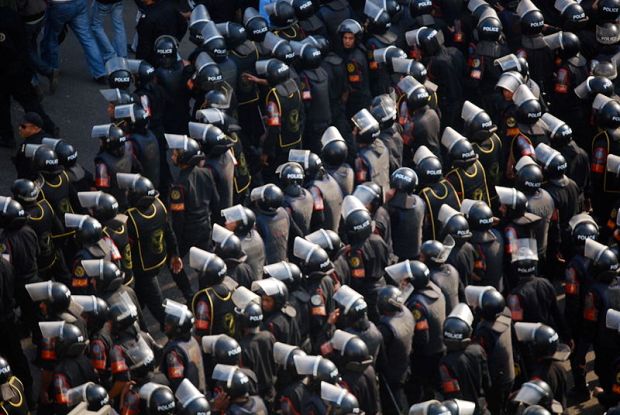Keep Calm and Enjoy the Silence: On the Pains and Pleasures of Doing Research in Egypt
/This is one of a series of blog posts created by the students in my PhD seminar, Public Intellectuals: Theory and Practice. Each student was asked to construct a post which shared some core insights from their research. I will be running them on my blog over the next few weeks. Keep Calm and Enjoy the Silence:
On the Pains and Pleasures of doing Research in Egypt
By Y. Elsayed
In the fall of 2006, I walked down Tahrir Square alone, after naively showing up to a protest that never took place. All I could muster was a look of silent disdain at the tens of security officers who showed up instead. Perhaps others showed up too, yet walked by when they did not see a crowd. This was one of the many moments when I realized that practicing politics in an oppressive regime required a different understanding of politics and its stakes than what we learned in books; taking part in a protest, for example, was not as simple as showing up to it; it required collective tactics, great flexibility, and organizational support to ensure, if you are caught that someone knows and can campaign for your release.
At the time, I admit to reaching a point, where I thought Egyptians were perpetually subordinate. I did not know, nor could I possibly predict, that four years down the road, this square will be packed with more than a million protesters, and that those walking about their lives disinterestedly would unpredictably display the highest levels of engagement and creativity.
|
|
In 2009, I left Egypt to join my husband who was doing his PhD at the time in the US. In those six years, a lot has changed not only in Egypt but in the personality of Egyptians themselves My longtime friend, who left Egypt right around the same time in 2008, to pursue a PhD degree in Canada, makes sense of this period by sharing Facebook memories of the last four years: memories, many of us did not have the capacity to make sense of or process at the time (The 18 days, the first referendum, clashes with the military council, Mohammed Mahmoud clashes, Bassem Youssef, parliament elections, the election of Morsi, rise of Islamists, the state crackdown on Ultras, June 30th, the military coup, Rabaa’, then they were too many to keep count). Perhaps sharing those memories and inviting us-- confused as we are-- to comment, was her way of managing them.
I, on the other hand, resorted to making these events the object of my research, thinking that a researcher's distance would protect me from being emotionally invested in the political and social turmoil. However, with the intensifying onslaught on dissent, I was deprived of my object of study: the public practices of mobilization and protesting. Traditional means of expression such as protesting and petitioning have mostly been stunted, following the crackdown on Rabaa square (see Amnesty’s Egypt’s darkest day) which resulted in hundreds of victims and injuries, The “Jailed and bailed” scenario for protesting, has been replaced with the far grimmer threat of “disappeared and tortured to death”, not only to protesters but to researchers as well (See End of Research in Egypt? The murder of my friend Giulio Regeni is an attack on academic freedom and AFTE: Banning researchers from entering Egypt threatens academic freedoms). How can I conduct interviews freely when I could be questioned for names of participants, or worse, for speaking in English in public! (See I was arrested for chatting in a Cairo café, and American Arrested for talking about Egypt’s January 25th revolution in English). How can I make claims about Egyptian youth, when I cannot conduct a reliable national survey without being flagged for asking a tad-political questions? The surveying agency itself is scrutinized by state security which reviews surveys, question by question. Even if I manage to get it through, how can I ensure truthful answers by self-censoring respondents? Consequently, my original plan of studying processes of social change was crippled.
|
|
On the personal level, my life and the lives of many Egyptians in and outside of Egypt were affected by the ripples of what was taking place on ground: continually forced to make adjustments not only to travel and study plans but to things as personal and intimate as who we are. It occurred to me that something has altered permanently in Egyptians. They became partly desensitized and at the same time traumatized by the daily blood scenes of state brutality, and state corruption. In their urge to lead a “quasi-normal” life while battling the effects of a declining economy, many, especially the older generation, pushed away these incidents by dehumanizing the victims thereby reducing sympathy for them, or at best remaining apolitical. This lead to polarization in Egyptian society between those who justify violence for the sake of a fictitious sense of security and those who uphold human dignity and aspire for change (the majority of which were youth). Polarization reached a dangerous point where discussion seized between friends and even close family members.
Furthermore, even though I could no longer ask my macro-research questions concerning processes of social change, the questions themselves failed to capture what I was witnessing on a daily basis this Summer, my first time in Cairo since six years: riding the metro, or walking down the streets of down town Cairo and its old districts, listening to people’s side-talks, their jokes, while observing their facial expressions and body language -- the daily acts of resistance that are building up for a … movement?
The answer came to me reading James Scott’s (1990) Domination and the Arts of Resistance, all while working as a research assistant for the MAPP project which follows and documents the work of activist groups practicing politics by any media necessary (http://byanymedia.org/works/mapp/index). In his study of peasant, serf and slave cultures, Scott notes that not only does resistance exist, but it can also be studied, just by living and navigating through the right spaces. This is what Scott describes as the study of “infrapolitics”, where in contrast to “the open, declared forms of resistance, which attract most attention”, it is “the disguised, low-profile, undeclared resistance” (p. 198). He calls it the “Hidden transcript”, in contrast to the public transcript: a decorous respect exhibited by subordinates in the presence of authority. This hidden transcript is often disguised in “rumors, gossip, folktales, songs, gestures, jokes and theater of the powerless where critiques of power can be advanced behind the innocuous understandings of their conduct” (Scott, 1990, p. xiii)
|
|
It occurred to me, that perhaps we are doing social change a disservice by focusing on the moments of the uprising, rather than the cultural build up for this moment. As Hakim Bey (2002) notes, “the vision comes to life in the moment of uprising – but as soon as ‘the Revolution’ triumphs and the State returns, the dream and the ideal are already betrayed” (p. 116). I hence shifted my research from the study of big actors to the study of the daily subjects, whose collectivity formed the millions in Tahrir Square and tipped the scale of power, even if temporarily to the side of youth. I turned to the “analysis of the hidden transcript” which Scott argues, “can tell us something about moments that carry the portent of political breakthroughs” (p. 202-203)
Five years following the 2011 uprisings and the celebration of the role of both social media and activists in mobilizing protesters, social media is still present and so are the actors (though some are in jail or abroad), yet the subjects are missing; they have been alienated by the polarization of political parties, which in turn resulted in a lack of leadership. In this highly charged political atmosphere, social media became of tool of polarization rather than mobilization (See Ghonim’s TED talk on designing social media that drives real change). Ghoneim who optimistically announced that “if you want to free a people, give them the internet” is now resorting to a more balanced view that social media is what people make of it.
At these times of polarization and social conflict, resistance can manifest itself culturally through arts and comedy as important tools in tracing our sources of conflict and deconstructing them without openly challenging strong held beliefs. Hugh Duncan in his Communication and Social Order, insightfully notes that through comedy and “safe disrespect”, we can “uncover the ambiguities and contradictions which beset us as we seek to act together”. This ambiguity can extend to all works of art, which not only carry the portent of subversiveness but do so in the safety of ambiguous artistic interpretations, where you can always claim to be passing a joke for example. Mary Douglas in her 1968 essay, notes how jokers “lighten the oppressiveness of a social reality”: a ‘ritual purifier’ performing a cathartic function for both him and society”.
The value of comedy is amplified at times of polarization not only between political parties but within circles of families and friends. A significant part of the political struggle of the Arab Spring is essentially generational, where the older generation generally favors a stable status quo without regards to demands of democracy (see Harrera). In a widely circulated tweet, Hamdy, who has over 30K followers tweeted “Someone tell Sisi, that we can now criticize him in front of our parents and relatives and they would remain silent, a year ago they used to get mad, yell and curse at us”.
Recently, Shady Hussein, a TV anchor for Abla Fahita – a widely watched TV light comedy show-- was heavily criticized and threatened for posting a video in which he (independently) distributed Balloons made out of condoms to Egyptian police officers on January 25th of 2016. Ironically, the day was officially celebrated as the “Day of the Police” four years after the revolution and countless victims. In an interview with Shady, he said
January 25th should be the day for the revolution, the Egyptian police pages are filled with threats such ‘as let them go down, we will show them’… Okay we are not going to protest, and we will not chant, for with one bullet they can take us out, but we will stay here to laugh and ridicule you
This was all an indication of how the forms and forums (Windt, Jr., 1972) for practicing politics were changing. And, so the researcher who was stuck with an empty Tahrir Square was granted an infra-googles (to go off Scott’s infrapolitics) by which I could trace out occurrences of everyday resistance, the hidden transcript in people’s mundane lives, their jokes, side-talks, arts and music.
It was a couple of days following Sisi’s grand opening of a Suez Canal branch, which was touted as a monumental achievement comparable to the digging of the Suez Canal (which itself has a history of slave exploitation). Partly disheartened by the Orwellian public transcript which was jubilant with propaganda songs played in Radios and speakers of metro stations and flags hung in balconies (see Sarah Carr’s President Sisi’s Canal Extravaganza), I began to entertain my old thoughts about Egyptians’ subordination. I decided to escape to the old, partly uncontaminated parts of historic Cairo, Al Ghoureya and Khan El Khalily, to replace the sounds of propaganda with the bustle of Egyptians’ lives. Inhaling an air loaded with the aroma of spices instantly brought back memories of the countless times I prayed in its historical mosque, Al Ghoury. Just two blocks away from the famous Al-Azhar, I preferred to climb up the worn out stone steps of this forgotten mosque to admire its ancient stone walls, its colorful glass and brass chandeliers, but also secretly hoping to catch a glimpse of the hidden transcript in a less official space.
The outside of Al Ghoury Mosque (Courtesy of http://www.panoramio.com/photo/28101722)
After praying, I went down to Khan El Khalily, the narrow alley and touristic attraction famous for its Pharaonic and Islamic art souvenirs. I wanted to purchase some of these souvenirs to bring back with me, but I also wanted to melt in the crowds again, to rub my shoulders against actual struggling Egyptians, and enjoy discussing politics with my mother as we walk down the aromatic alley. Lightly tapping her shoulder so she can go easy in her price bargaining with the already impoverished street vendor trying to sell me a 2$ (15 L.E) piece of jewelry for 5$ (35 L.E), we heard someone yelling, “THE LAUGH OF SISI”
We turned our heads to see a street vendor passing through the alley while pushing her worn-out newsstand. She was calling at the top of her lungs, with probably the headline of a newspaper she proudly adopted and supplemented with prayers for Sisi’s success in “conquering Egypt’s enemies”. Yet, I could hear too, to my secret happiness, the disgruntled murmurs of the small shop owners and other street vendors, negatively affected by Sisi’s repression and economic policies, as they cursed, and urged her to leave. Now all of a sudden, the request of my affluent aunt to watch the “Sisi extravaganza” on our TV during her visit, no longer upset me that much.
Y. Elsayed is a doctoral student at USC’s Annenberg School for Communication and Journalism. She studies forms of cultural resistance and processes of social change in post-Arab Spring countries; Elsayed particularly focuses on mapping out non-traditional means for practicing politics in non-democratic settings, through the study of youth's satire, sports fandom, arts and music.


































